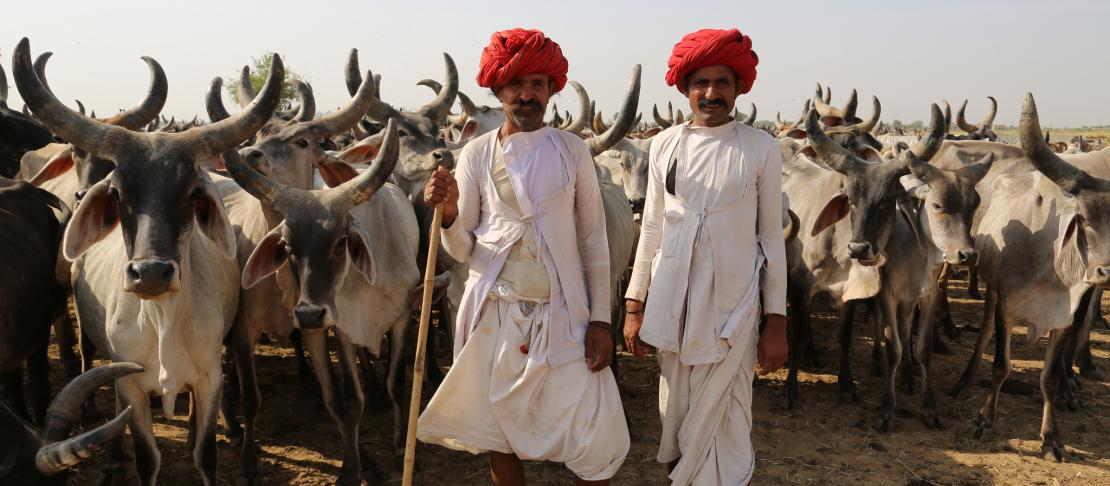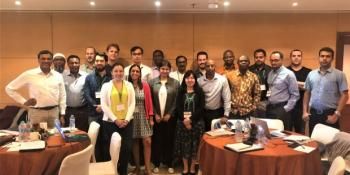A livelihood on the move: surviving on marginal lands in Rajasthan, India

A new study aims to understand the migration practice of livestock herders in Rajasthan, India, in the larger context of a changing climate, the economy, and the sociological system.
Rajasthan, India’s largest state located on its western side, is 55 percent desert. Its remaining land is in danger of desertification. For the poor living in these parts, livestock is an important means of livelihood.
With scarce and erratic rainfall, and frequent droughts in the region, a pastoralist community of Rajasthan, Raikas follow the practice of moving their flocks and herds in search of water and forage. However, today Raikas are facing bigger challenges for survival than ever before. Rainfall, the only source of water in the region, is becoming increasingly variable and droughts are more frequent with climate change. As a result, Raikas are finding it harder to predict where to find fodder and water.
The Raikas have evolved the practice of migrating their flocks and herds during the dry season for over five centuries. They is a clear division of responsibilities and roles amongst its members, from charting migration routes to tending the herds and looking after natural resource management. The traditional knowledge vested in the community has allowed them to endure periodic severe droughts, which are common in the region.
Migratory pastoralism practices such as these prove to be one of the most resilient livelihood systems on marginal lands the world over. The herds are grazed on common pastures and fallow farmlands. Their mobility prevents overgrazing, allowing natural vegetation to grow back – an important best practice for managing degraded lands. This climatic and resource based adaptation requires no external inputs. With little to no government assistance, it is a viable and self-sustained way of living for the Raikas.

For the poor living in these parts, livestock is an important means of livelihood
Photo: ICARDA
As urbanization is spreading, the migratory practice of herders are faced with growing challenges. Raikas are finding it harder to provide for their livestock with expanded cultivation and restrictions on grazing in forest reserves. Invasive species have spread in many of the rangelands that are not edible, further deteriorating grazing areas. The absence of institutional support has made these challenges even worse.
A multi-disciplinary team of rangeland, socio-economist, veterinary and spatial analyst (GIS) scientists from The International Center for Agricultural Research in the Dry Areas (ICARDA), Oregon State University (USA) and the Central Arid Zone Research Institute (CAZRI) in India conducted a study to understand the migration practice in the larger context of the environment, the economy, and sociological system. The project, funded by the CGIAR research program on Climate Change, Agriculture and Food Security (CCAFS), aimed to inform formulation of policies and government initiatives that could improve the livelihoods of Raikas. The project team led by ICARDA gathered socio-economic data using Participatory Rural Appraisal methods to survey Raikas’ community members. The scientists also tracked the movement of cows and sheep herds using animal GPS collars, in an innovative approach, allowing information on exact migration routes, time spent grazing in different plant communities, time taken to reach watering points, and distances travelled.
The results from analysis are now guiding the policy-makers and government officials to take measures that could facilitate the movement of Raikas. The scientists estimate significant impact from implementation of even one of the many recommendations concluded from the study, such as improving the conditions of common grazing lands on migratory routes, creating watering points, access to near real-time information through mobile phones on conditions of forage resources, and mobile veterinary services. The study also identified an opportunity where Raikas could add value to the local economy by selling livestock and its products in local markets along their migration route. These products could be sold as organic products at remunerative prices as they are from a free range production system that does not use chemical inputs.
The project concluded with an all-stakeholders meeting bringing the decision-makers together with the community and the project scientists in a productive dialogue. The project results, along with hearing first hand from Raikas made a convincing case for the government officials to factor in the many challenges faced by the community and adapt their policies and programs to inclusively benefit these communities.
Today there are 30-40 million migratory pastoralists in the world living on marginal lands. These resource-poor populations are particularly vulnerable as climate change is predicted to hit marginal lands the worst. Livestock mobility could serve these communities as an beneficial coping strategy as it effectively responds to the uncertainties in their livelihoods.



